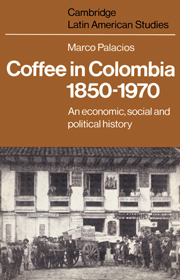Book contents
- Frontmatter
- Contents
- List of tables
- List of figures
- List of maps
- Preface
- Acknowledgements
- 1 The Colombian export economy in the second half of the nineteenth century
- 2 The making of an oligarchy
- 3 Land and society in central Colombia in the second half of the nineteenth century
- 4 The internal structure of the coffee haciendas, 1870–1930
- 5 Living conditions and internal contradictions in the hacienda structure
- 6 Inflation, devaluation, and export taxes, 1870–1904
- 7 Crisis and transition towards the second cycle of expansion, 1903–10
- 8 Private appropriation of public lands in the west
- 9 Sociopolitical elements in antioquen̄o colonization
- 10 Coffee expansion and the strengthening of the Liberal model of development, 1910–50
- 11 The international cycle and coffee policies confronting the peasant, 1930–70
- Appendix 1 Sample of coffee estates in Cundinamarca and Antioquia, 1870–98
- Appendix 2 Piece-rate wages on two coffee haciendas, 1879–1933
- Appendix 3 Concentration of the coffee export trade (percentage controlled by 20 leading companies), 1933–70
- Appendix 4 Foreign exchange rates in Colombia, 1870–1970
- Weights and measures
- Glossary
- Notes
- Biblography
- Index
- CAMBRIDGE LATIN AMERICAN STUDIES
1 - The Colombian export economy in the second half of the nineteenth century
Published online by Cambridge University Press: 06 October 2009
- Frontmatter
- Contents
- List of tables
- List of figures
- List of maps
- Preface
- Acknowledgements
- 1 The Colombian export economy in the second half of the nineteenth century
- 2 The making of an oligarchy
- 3 Land and society in central Colombia in the second half of the nineteenth century
- 4 The internal structure of the coffee haciendas, 1870–1930
- 5 Living conditions and internal contradictions in the hacienda structure
- 6 Inflation, devaluation, and export taxes, 1870–1904
- 7 Crisis and transition towards the second cycle of expansion, 1903–10
- 8 Private appropriation of public lands in the west
- 9 Sociopolitical elements in antioquen̄o colonization
- 10 Coffee expansion and the strengthening of the Liberal model of development, 1910–50
- 11 The international cycle and coffee policies confronting the peasant, 1930–70
- Appendix 1 Sample of coffee estates in Cundinamarca and Antioquia, 1870–98
- Appendix 2 Piece-rate wages on two coffee haciendas, 1879–1933
- Appendix 3 Concentration of the coffee export trade (percentage controlled by 20 leading companies), 1933–70
- Appendix 4 Foreign exchange rates in Colombia, 1870–1970
- Weights and measures
- Glossary
- Notes
- Biblography
- Index
- CAMBRIDGE LATIN AMERICAN STUDIES
Summary
The way towards ‘civilization’
Judging from its limited participation in international trade, Colombia during the nineteenth century was one of the poorest countries of Latin America, with a backward and stagnating economy. Nevertheless, the size of Colombia's exports has never really given an indication of the extent of economic activity in the country. Historically, a large section of the economy has been relatively isolated from the international trade and its accompanying cycles of booms and busts. For example, the sharp fall in gold exports between 1600 and 1650 did not lead to a similar depression of the internal market. The latter, on the contrary, showed signs of dynamism. Again, in 1884 during a marked contraction in the export market, Salvador Camacho Roldán (one of the most distinguished economists of the time) calculated that the value of the agricultural produce sold for internal consumption – excluding subsistence agriculture – was 120 million pesos, over twelve times the value of agricultural exports, which then amounted to 10 million pesos. Even adding the figures for gold exports, the coefficient of total Colombian exports was rarely over 10 percent. The one period which seems to have been an exception to the rule was the first half of the 1870s, when the export economy began to expand.
The low export coefficient was certainly the result of the Colombian economy's isolation from the flow of capital, manpower, and technology from Europe to the temperate zones of the world. A straightforward quantitative history of Colombia's exports is still not possible.
- Type
- Chapter
- Information
- Coffee in Colombia, 1850–1970An Economic, Social and Political History, pp. 1 - 24Publisher: Cambridge University PressPrint publication year: 1980



